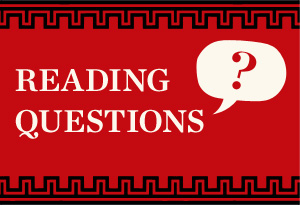Reading Questions for A Tale of Two Cities by Charles Dickens
Spoiler alert: Questions may contain spoilers

Below is the complete list of reading questions and topics for your book club discussion of A Tale of Two Cities by Charles Dickens. Click on the links below each question to share your thoughts with a world of readers.
1. A Tale of Two Cities opens with "It was the best of times, it was the worst of times..." one of the best-known passages in English literature. What does Dickens mean by setting the stage with such polarities? For whom was it the best and the worst of times? Dickens wrote A Tale of Two Cities in the late 1850s. Why does this passage continue to be quoted today? In what ways does our own present period merit such an assessment?Share your thoughts
2. The novel takes place, as its title suggests, in two cities: London and Paris. What are some of the differences between these two cities? Between their denizens? What about characters who travel—or move residence—from one to another? How are the cities themselves divided in two?
Share your thoughts
3. Why does Dickens describe Madame Defarge in her early scenes as seeing nothing? "Madame Defarge was a stout woman of about his own age, with a watchful eye that seldom seemed to look at anything..." (page 33). "Only one soul was to be seen, and that was Madame Defarge—who leaned against the door-post, knitting, and saw nothing" (page 49). Why does this depiction of her change?
Share your thoughts
4. Why was Charles Darnay able to see the unfairness of the class structure that benefited him and then able to extricate himself from it? Are there other characters as capable of seeing beyond their own circumstances?
Share your thoughts
5. Dickens seems to have great sympathy for the poor, the sick and the powerless, but not all such characters are portrayed sympathetically. What does that say about his sympathies? Where does he intend our sympathies as readers to lie?
Share your thoughts
6. The news that Doctor Manette, while imprisoned, denounced all the descendants of the Evrémondes comes as a shock. Why would he have made such a declaration? What can we make of his repeated claim in the letter read aloud during Darnay's retrial that he was in his right mind? How does he really feel about Darnay and his marriage to Lucie?
Share your thoughts
7. What is Defarge's motive in betraying Doctor Manette, endangering his daughter and grandchild and framing Darnay? How might the relationship between Madame and Monsieur be described?
Share your thoughts
8. Sydney Carton's background is alluded to, though we never quite learn the source(s) of his disappointment and degeneracy. What might have happened in his past?
Share your thoughts
9. Late in the novel, Carton is described as showing both pity and pride (page 332). Until this point in the novel, "pride" is a word we have not seen associated with Carton, who is full of mostly suppressed regret and anguish over his wasted life. What is Carton proud of, and do others see it? Do you think Dickens intends to convey that others see his pride?
Share your thoughts
10. Carton has clearly misused his youthful promise and believes himself to be unredeemable. Does this view of himself change? If so, how? Is Carton a man of faith? Does he become one?
Share your thoughts
11. Lucie finds "faith" in Carton, described as a "lost man" (page 205), after he confides in her. Does Lucie come to understand Carton? How? Does she believe that he can be saved from himself?
Share your thoughts
12. Dickens prefaces the final paragraphs of the novel, which are in Carton's voice, by noting that "if he had given any utterance to his [thoughts], and they were prophetic, they would have been these" (page 371). How might we read the vision expressed in these words? Are we meant to take these thoughts as prophetic—that is, as a portrayal of what actually came after the end of the novel, in both France and in England? Among the beloved friends he has left behind?
Share your thoughts
13. The vision expressed in Carton's supposed final words includes one for the country and its people after the newest "oppressors" are put to death. What would such a post-Revolution world be like, and how could it be achieved?
Share your thoughts
14. The French Revolution was of great interest to Americans in the early days of their own republic. Given today's polarities of extreme wealth and poverty and strongly expressed patriotism, as well as the interest in early America, what parallels might we draw between our own time and what happens in A Tale of Two Cities? What lessons?
Share your thoughts
Penguin Books and Penguin Classics wish to thank and credit the following writers and books for information used in creating this Reading Group Guide:
Janice Carlisle (editor), Charles Dickens, Great Expectations: Case Studies in Contemporary Criticism, New York, Bedford Books of St. Martin's Press, 1996
Edmond Jabes, The Book of Questions (Volume 1), Middletown, CT., Wesleyan University Press, 1976
Fred Kaplan, Dickens: A Biography, New York, William Morrow & Co., Inc., 1988
Norman Page, A Dickens Chronology, Boston, MA., G.K. Hall & Co., 1988
Janice Carlisle (editor), Charles Dickens, Great Expectations: Case Studies in Contemporary Criticism, New York, Bedford Books of St. Martin's Press, 1996
Edmond Jabes, The Book of Questions (Volume 1), Middletown, CT., Wesleyan University Press, 1976
Fred Kaplan, Dickens: A Biography, New York, William Morrow & Co., Inc., 1988
Norman Page, A Dickens Chronology, Boston, MA., G.K. Hall & Co., 1988



